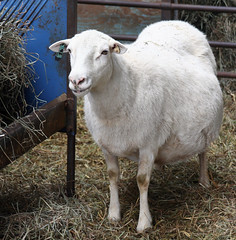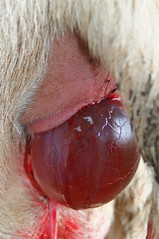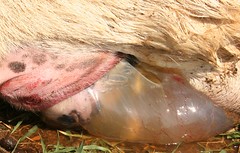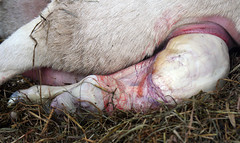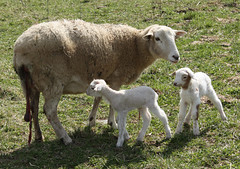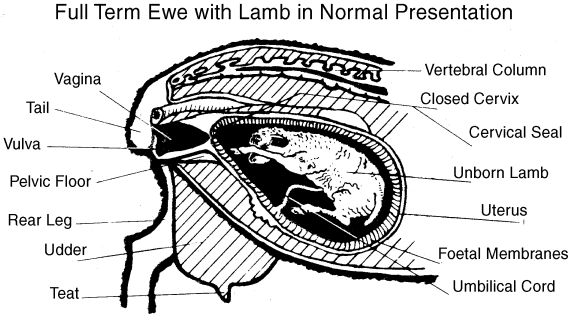- Sheep 201 Index
- Other web sites

Backwards
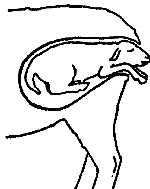
Elbow lock

One leg back
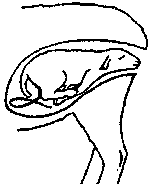
Both legs back
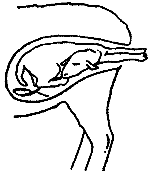
Head back

Breech
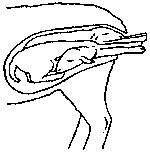
Four front legs

Front and back
Presentation images courtesy of Ontario
Ministry of Agriculture & Food Economy
© Queen's Printer for Ontario, 1999.
The lambing process
The lambing process has evolved over thousands of years and most ewes will lamb normally without any trouble or need for assistance. However, understanding the lambing process can help you understand when a ewe is ready to give birth and when it may be necessary to lend a helping hand.
The whole lambing process is controlled by a complex series of hormonal changes. It is the lamb who decides when it is time to be born. When a ewe is getting ready to deliver her lambs, she may not eat. Her udder and teats will be distended. Her vulva will be dilated. She will appear a bit hollow just in front of her hips, and she'll be not as wide and full over the rump, because the musculature there will have relaxed. The process sometimes appears "confusing" to first-time mothers, especially yearlings.
Lambing
Lambing is divided into several phases. In the first phase, the cervix dilates and the birth canal is prepared for delivery. This phase lasts for approximately 12 to 24 hours. At the end of this phase, a clear-whitish discharge will appear. The presence of the mucous discharge means that lambing has begun. In the next phase, uterine contractions will increase.
As labor progresses, the ewe will spend more time lying down on her side with her head turned in the air. Eventually, a large "bubble" or water bag will appear, break, and expel the water. At this time, the tip of the nose and front feet of the lamb can be felt. The lamb is expelled. As ewes often have multiple births, the same sequence of the rupture of the water bag and expulsion of the lamb will be repeated for the delivery of each lamb. Ewes will vary in the time taken to complete lambing.The last stage of lambing includes the expulsion of the afterbirth or placenta. The placenta is usually expelled 30 to 60 mintues after the delivery of the last lamb. If the placenta is not expelled after 24 hours, there may be a problem. The ewe will eat the placenta because her instincts tell her to hide evidence of lambing to protect her offspring from predators. The placenta should be discarded to prevent the spread of disease and scavenging by dogs.
© Queen's Printer for Ontario, 1999.
Dystocia: assisting with difficult births
Dystocia (or difficult births) is one of the leading causes of newborn lamb death. A New Zealand study showed that dystocia accounted for about 50 percent of deaths among newborn lambs. There can be many causes of dystocia in a flock:1) Abortion
2) Disproportionate size of the ewe and lamb
3) Malpresentation of the fetus
4) Failure of the cervix to dilate
5) Vaginal prolapse
6) Deformed lambOne of the most difficult aspects of shepherding is knowing when and how to assist a ewe during lambing and when to call for help. It is generally recommended that if a ewe has been straining for over an hour and has nothing to show for it, it is time to check things out. Before entering a ewe, be sure to remove watches, rings, and other jewelry. Wash your hands in warm, soapy water and clean backside of the ewe.
Gloves or sleeves should be worn during the examination. Coat your hand up to your elbow with a non-irritating lubricant. The liberal use of a lubricant cannot be overemphasized. Bunch your fingers and thumb into a cone shape and insert them into the ewe's vagina. If the cervix is open, you should feel the lamb's nose. Next, you need to determine where the lamb's front legs are. If the presentation is normal, the ewe should be able to deliver the lamb on her own, unless it is too big for her pelvic opening.
You should not keep pulling your hand in and out of the ewe and should not change hands without washing again. Getting the ewe to stand up or elevating her hindquarters will allow more room for repositioning and result in less vigorous straining. If you have worked for a half hour with no progress, it is a good idea to call a veterinarian or a more experienced shepherd. Excessive stress in pulling and delayed delivery can result in a dead lamb and serious injury to the ewe.
A live lamb will assist to some extent with its own birth. There is never enough room in the birth canal to correctly position a lamb. The lamb must be returned to the uterus before any corrections can be made. You should not attempt to deliver a lamb when the birth canal is only partially dilated. This can seriously damage the ewe. After all deliveries, check to make sure that there are no other lambs remaining in the uterus. After any assisted delivery, you should give the ewe an injection of a long-acting antibiotic.
Normal presentation
Normal delivery is when the two front feet appear with the head resting between them. Rarely is any assistance needed. However, a small ewe may have trouble delivery a very large lamb. In this case, gentle assistance may be needed. You should pull the lamb downward during her contractions.
Backwards
A backwards (hind legs first) delivery is also a normal delivery. It is common with twins and triplets. You should never attempt to convert a backwards delivery to a "normal" frontwards delivery. Turning a lamb around can result in death of the lamb or damage to the uterus. Plus, it is not necessary.
Elbow lock
An elbow lock is a "normal" position except the lamb's elbows are locked in the birth canal. You will need to push the lamb slightly back into the birth canal to extend the legs.
Leg(s) back
If one or both legs are back, you need to cup the lamb's hooves in your palm and bring them forward. A small lamb may be pulled with one leg back. If you are not able to bring the legs forward, you should slip a lambing rope onto one or both limbs and push the head back far enough to allow the legs to be drawn forward.
Head back
If the front legs are forward, but the head is back, you will need to push the lamb back into the uterus, so you can turn the head around. You should attach a lambing rope to each leg so you don't lose them. The lamb should not be pulled out by the jaw. A lamb with a broken jaw cannot suck and will likely die. You can use the eye sockets to pull the lamb's head.
Disproportionate size (tight birth)
Many lambing difficulties are due to the disproportionate size of the lamb and ewe. This can be the result of a large lamb, a small pelvic opening, or both. It is most common with young ewes and flocks that have a majority of single births. Lubrication and gentle, but firm assistance will usually alleviate the problem. You may have to pull the skin over the head. Extending one leg at time may also help.
Breech
A "true" breech birth is when the lamb is positioned backwards, with the rear legs tucked under and only the tail near the opening. A breech birth is common when the ewe has been straining for a long time and there is very little discharge and only a small water bag.
To deliver a breech lamb, the first thing you have to do is bring the rear legs forward by cupping the fetlocks in your palm. Once the rear legs are forward, you need to quickly deliver the lamb because once the umbilical cord breaks, the lamb will begin breathing and could risk drowning in its own fluids.
Swollen head
If the head has been outside the vulva for a long time, it may have become very swollen. The tongue may be sticking out. While it may appear cold and dead, a lamb can survive for long periods of time in this position. If the head is covered with straw and feces, it will need to be washed before being returned to the uterus. Plenty of lubricant should be used. Margarine is an excellent lubricant for this purpose. If the lamb is dead, it is often easier to remove the head.
Simultaneous births
Sometimes, lambs are presented with their legs intertwined. Before attempting to deliver these lambs, you need to determine which legs belong to which head. It may be necessary to repel one lamb to allow easy delivery of the other. Ewes carrying triplets often have a higher percent of malpresented lambs, so flocks with high lambing rates require closer supervision during lambing.
Dead and deformed lambs
The removal of delivery dead and deformed lambs often requires veterinary assistance. Deformed lambs often cannot pass through the birth canal. If a lamb is freshly dead, it may be possible to extract it, but lambs that have been dead for some time often must be removed in pieces.If your flock experiences excessive lambing problems, you need to consider your breeding and nutrition problems. For example, a lot of oversized lambs could mean you are overfeeding you ewes during late pregnancy or using too large of a sire breed on your ewes. In addition, ewe lambs should not be bred until they have developed sufficiently. The rule of thumb is not to breed ewe lambs unless they have achieved approximately 70 percent of the mature weight.
Ringwomb
After Lambing
Failure of the cervix to dilate is called "ringwomb." It is one of the most difficult lambing problems to deal with. True ringwomb does not usually repsond to any medical treatment or to manipulation of the cervix. A caesarian section is usually the only viable option to save the ewe and/or lambs.
Ewes experiencing ringwomb should probably be removed from the flock. Ringwomb occurs most commonly in ewe lambs. Selenium deficiency is considered to be a contributing factor, but the condition is not fully understood. Its exact cause is unknown, though it is believed to have a genetic component.
After a normal lambing, the ewe can usually take care of her newborn lambs. It is best not to interfere. In unusual cases, it may be necessary to wipe the mucous from the lamb's nostrils to permit breathing. You'll want to make sure that the ewe claims each of her lambs and allows them to nurse. A vigorous lamb will get up and nurse within a half hour to an hour after birth. Make sure each lamb gets colostrum, the first milk produced after lambing.
The lambing process
<= SHEEP 201 INDEX
Copyright© 2021. Sheep 101 and 201.

